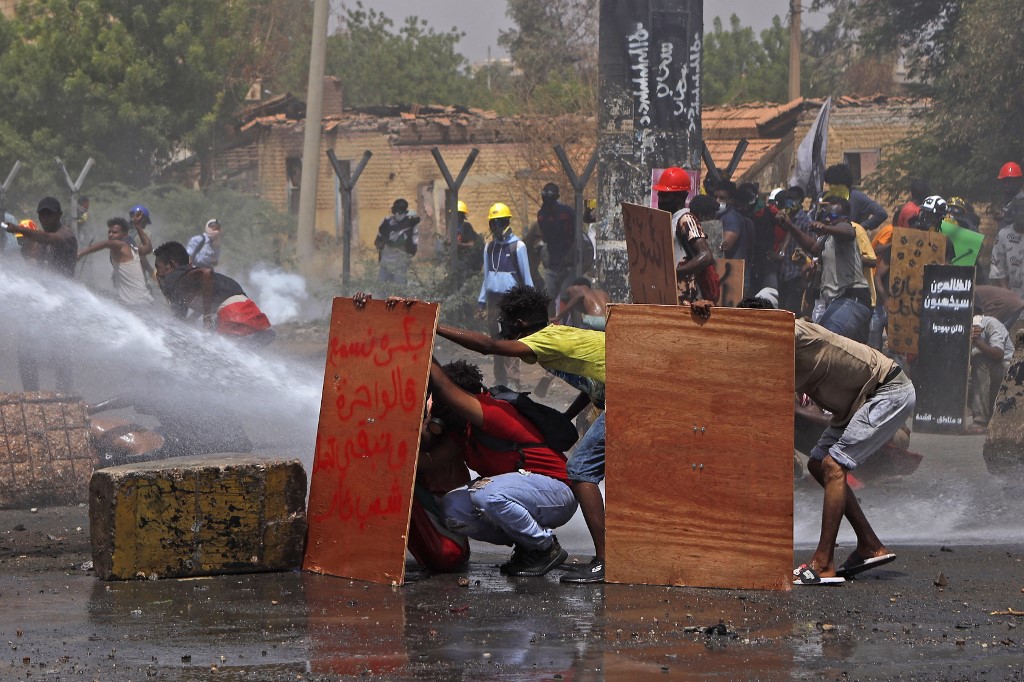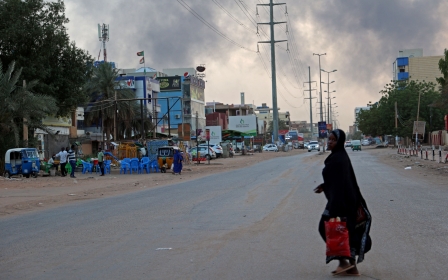Sudan timeline: From the fall of Bashir to street-fighting in Khartoum

Clashes between the Sudanese Armed Forces (SAF) and the powerful paramilitary Rapid Support Forces (RSF) have been brewing for months and are now threatening to plunge the country into a full-blown civil war.
Below is a timeline of Sudan's recent years of political upheaval.
December 2018: Hundreds come out to protest in the city of Atbara against rising bread prices, widespread corruption and unemployment as Sudan faces a worsening economic crisis.
Protests quickly spread to other parts of the country, finally reaching the capital Khartoum. Security services respond with tear gas and gunfire, and protesters call for the country’s longtime ruler Omar al-Bashir to step down.
April 2019: Hundreds of thousands of people come out on the streets and stage a sit-in in front of the army headquarters in Khartoum.
Within days, Bashir had been ousted and detained by the army, ending his 30-year grip on power. The army, one of the main powerbrokers in the country, quickly moves to consolidate control, suspending the constitution and imposing a three-month state of emergency.
A transitional military government is formed but protests continue with calls for power to be handed over to civilian authorities. But attempts to break the impasse between the country’s military and protesters collapse.
June 2019: Armed men linked to the RSF militia kill at least 128 people in the capital, in what came to be known as the Khartoum massacre, in a bid to break up the protest movement.
The feared paramilitary group, which was formed from militia groups accused of war crimes in the 2003 Darfur conflict, denies that it was behind the attack. Demonstrations continue, with protesters calling for an end to the “coup and block the path of any fake alternatives”.
August 2019: Following mediation by the African Union and Ethiopia, civilian leaders and the military agree to share power for a three-year transition period. Elections are scheduled for 2023, and a council of ministers is formed under Prime Minister Abdalla Hamdok.
On 17 August, a “constitutional declaration” is signed, bringing to an end months of upheaval.
Under the terms of the deal, the first 21 months of the transitional period would be led by the military and then followed by civilian rule. The deal faces criticism from protesters who fear the army may renege on their promise.
December 2019: On 14 December, Bashir, the country’s deposed ruler, is convicted of corruption and sentenced to two years in a correctional centre.
March-July 2020: Hamdok, Sudan’s transitional prime minister, survives an assassination attempt on 9 March.
Skyrocketing inflation of more than 100 percent and the Covid-19 pandemic result in increasing economic woes, and the government is forced to announce a currency devaluation.
Street demonstrations continued in June, with thousands demanding justice for people killed under Bashir’s rule.
Bashir faces trial on 21 July on charges related to the 1989 coup that brought him to power.
October 2020: Sudan's government and a number of rebel groups from the restive Darfur, Blue Nile and South Kordofan provinces sign a landmark peace deal that aims to end decades of conflict that have cost hundreds of thousands of lives. But two of the most powerful rebel groups do not sign the agreement.
December 2020-January 2021: Sudan moves to normalise ties with Israel in return for removal from the US's state sponsors of terrorism list and financial incentives to reduce the country's debts and encourage foreign investment.
On 14 December, the US ends Sudan's designation as a state sponsor of terrorism. On 6 January, the transitional government signs the Abraham Accords, joining the United Arab Emirates, Bahrain and Morocco by officially recognising Israel.
February 2021: A new government is formed to include seven ministers from former rebel groups, but growing fractures with the fragile civilian alliance quickly emerge.
September-October 2021: An attempted coup on 21 September is thwarted by military figures linked to the country’s former ruler Bashir.
In October, a splinter faction from the civilian protesters call for the military to take power and rule the country. Other civilian factions come out on the streets in a show of support for the civilian government.
On 25 October, Sudanese armed forces arrest five ministers from the transitional cabinet, including Prime Minister Abdalla Hamdok.
The coup is led by General Abdel Fattah al-Burhan and the deputy head of Sudan's ruling council and leader of the RSF, General Mohamed Hamdan Daglo, also known as Hemeti.
November 2021: Mass protests against the coup result in Hamdok being reinstated as prime minister.
January 2022: Unable to form a new government and facing continuing protests, Hamdok resigns from his post.
June 2022: The UN World Food Programme says more than a third of Sudan's population faces food insecurity and blames ongoing political, economic and climate shocks buffeting the country.
October 2022: Huge crowds take to the streets of Sudan in anti-military demonstrations marking the one-year anniversary of the coup.
December 2022: An agreement is signed by civilian groups sidelined by the military in the coup of 2021 and a new two-year political transitional period starts.
April 2023: A power struggle between de facto head of state Burhan and his deputy, Daglo, simmering for months breaks into the open.
In a statement, Sudan's military warns of the mobilisation and redeployment of troops by the RSF in the capital Khartoum and other cities without its approval, and of potential armed confrontations.
On 15 April, clashes break out between the SAF and the RSF near the army headquarters and the airport in Khartoum as well as at other strategic military sites around the country. The SAF carries out air strikes targeting RSF forces, who respond with artillery and anti-aircraft weapons, turning central Khartoum into a war zone.
Middle East Eye propose une couverture et une analyse indépendantes et incomparables du Moyen-Orient, de l’Afrique du Nord et d’autres régions du monde. Pour en savoir plus sur la reprise de ce contenu et les frais qui s’appliquent, veuillez remplir ce formulaire [en anglais]. Pour en savoir plus sur MEE, cliquez ici [en anglais].








